Here I go again - voluntarily leaping onto the slippery slope of writing an article for the Atlanta Photographic Society’s “News & Views” blog. You would think I would know better by now!
My original intention was to talk about LED (light emitting diode) lights for photography and videos before getting into specifics of light and color science. But I quickly found that you cannot talk or write about these lights and their uses without getting into “color temperature” and “white balance.” Some photographers mistakenly talk and act as if these two things are the same. They are not.
Beginning with Some ABCs
First, what are LEDs? I wish there were a short and simple answer to that! LEDs are a special class of semiconductor devices that - get ready for it - emit light. Diodes are semiconductors which pass and modify direct-current electricity in one direction only. Diodes have many uses on circuit boards. Invention of LEDs is credited to Russian inventor Oleg Losev in 1927, but no real-world applications were developed for several decades. Then, beginning in earnest about 1960, uses for LEDs went wild, first as on-off indicators and numerical readouts on small things like hand-held calculators and remote control devices, then for automotive dashboard and turn-signal indicators, and more recently as real light sources for homes, cars, and photography. The more powerful LEDs are much more energy efficient than heated-filament lamps or fluorescent tubes. They represent the future.
If you feel you are up to speed on Color Temperature and White Balance, please feel free to skip over the next several paragraphs and go straight to the video. Or, please just scan through this and send me your suggestions. I need help!
The modern study and theories about the color of light began with Sir Isaac Newton, 1642-1727, (more famous for his studies of mathematics and motion). Many, but not all, of his ideas about light were correct. Scottish scientist James Clerk Maxwell and others amended Newton’s theories. The basics of color science have been known for a very long time, including that light visible to humans, coming from the sun and other sources is made up of a mixture of wavelengths, with red being the longest, blue the shortest, and greens in the mid-range. The primary colors of light are red, green, and blue (RGB), because that is how our eyes see colors. Thus, the first color films and later digital cameras were built to work that way, too. Mixing RGB light lets us create almost any color. That is how our TV and computer screens, camera monitors and electronic viewfinders work. Note that white light is always a mixture - there is NO single wavelength for white
light.

Sir Isaac Newton - Sir Isaac Newton was one of the foremost thinkers of the 17th century. His theories of gravity and motion form the basis of modern physics, and he is credited with inventing Calculus and the reflecting telescope. Experimenting with prisms and lenses, he discovered and explained that white light is made up of mixed colors of light.
We are strictly talking about colors of light here, NOT crayons, inks, dyes, colorants, or pigments used in drawing, painting, or printing. That is a subject for a different article.

Color Temperature/Color Temperature Scale - Describing color of light in terms of “color temperature” is based on the color of light emitted by a black body (a theoretical ideal radiator, most often simulated by the element tungsten) at a temperature measured in degrees Kelvin (same as Celsius but beginning at absolute zero: minus 273 degrees Celsius). As the black body increases in temperature, the emitted light changes from yellow and red, to green and to blue.
Since we are already well into (beyond?) the limits of my understanding of physics, and in all likelihood beyond your patience with this blog, let’s just make a simple statement that COLOR TEMPERATURE is the modern scientific way to describe colors of light. The “temperature” part refers to how hot the glowing “black body” (typically a tungsten filament) must be to emit a certain color of light. And, color temperature uses the Kelvin scale, which has other exotic uses in physics, chemistry, and astronomy where very cold and extremely hot temperatures need to be measured and expressed. A final concept I propose, without offering any detailed explanation: light and heat are not the same things, although they frequently come from the same source and you sense them simultaneously with your eyes and skin. Please just trust me on that one and let us move on.
All of this is what is known in texting lexicon as “TMI!” - Too Much Information!
Color Temperature Explained
OK - back to color temperatures of light, and things photographic: A candle emits light at about 1,000 to 1,500 kelvins, and a small wood fire somewhere above 2,000K. A conventional incandescent light bulb (which you cannot buy anywhere in the USA these days!) is about 2,800K, and a tungsten/quartz/halogen photo lamp has a nominal color temperature of 3,200K. By the way, 3,200K is called “Tungsten Balance” when referring to photographic color films, lights, and digital camera settings. Average daylight, which varies with seasons, time of day and latitude, is usually expressed as about 5,600 kelvins, and that is called “Daylight Balance.”
Wait. What happened to the 4,000’s? That big gap is where green light happens and where fluorescent lamps often put out their light. Same for those very bright mercury vapor and other special lamps used for sports stadiums, arenas, and large factories. All those lamps and tubes often have a greenish cast which your eye may not detect, but which you need to deal with when shooting with color film or in color digital photography.
Photographic color temperature extends on up to clear blue sky at about 7,000 and sunlight through cloudy skies above that. Finally, if you are photographing around welding operations, acetylene torches and arc welders flashing will tinge your photos blue.
White Balance
Next is the concept of “white balance.” That term came to photography with the introduction of digital cameras, imported from the world of television and video. There was no camera setting for that in film days. White balance does not change or describe the light. It is a setting you put on your digital or video camera to tune or match the camera’s image sensor and firmware to the predominant color of light hitting your subject, ambient or artificial, or a mixture of the two. White balance does not even have to be white! The quickest and easiest way to set your camera’s white balance is to click on an icon or label (a pre-set, average value) for daylight, shadow, open sky, tungsten, or fluorescent. Quick and easy, and accurate enough to get your image capture in the ballpark, but probably still requiring some adjustment and fine-tuning in post-production. Yes, you can also use a numerical color temperature when setting white balance.
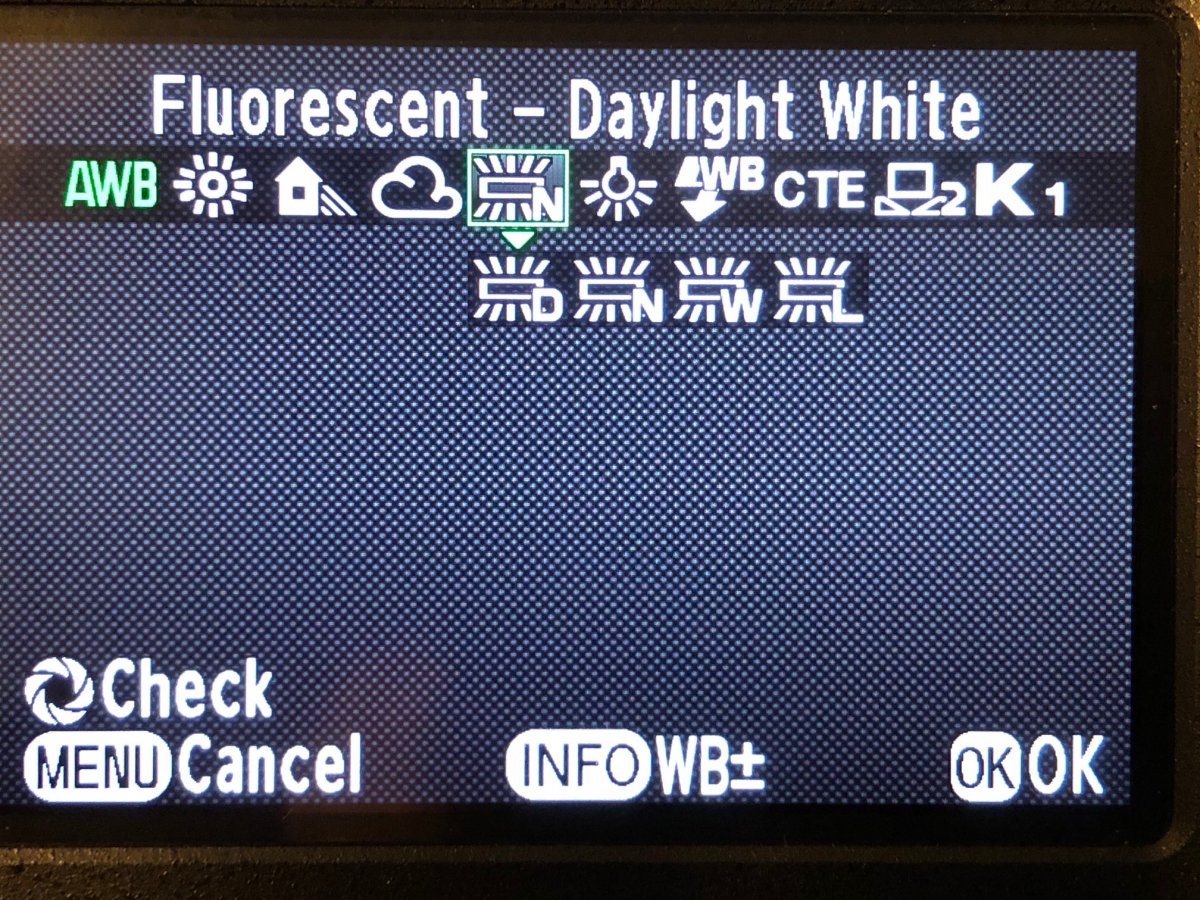
White Balance - White balance label from the Pentax camera menu, as it would be selected to set camera for photos or video exposures under “daylight fluorescent” illumination. Other options could include “warm white” or “cool white.” On some cameras, these pre-set options might be less accurately shown and lumped together as simply “fluorescent."
This slippery slope reminds me of when Alice fell into the rabbit hole and wound up in Wonderland, where everything and all characters seemed to be crazy. When Alice attended a tea party with the March Hare and the Mad Hatter, the Hare criticized Alice for not saying what she meant. “But I mean what I say, and that’s the same thing, you know,” Alice replied. “Not the same thing, a bit!” harrumphed the Mad Hatter. So, we should all say what we mean, and mean what we say. I get grumpy when a photographer casually lumps together color temp and white balance as if they are the same thing. But I digress. I am bad to do that.
What about “Auto White Balance”? That is a viable option for camera set up in many situations, like shooting outdoor scenes, or indoors with an undefined mixture of electric lights plus significant daylight. Auto WB is my preferred setting for casual shooting outdoors. But, if you have ambient light and you are using LED fill or key light at the same time, Auto WB can solve for one or the other, but not both.
In the video below, I use a couple of different LED lights, and show one way to adjust and correct image color balance using a reference gray scale card (which needs to be included in one frame of your group of shots done under each particular light), and RGB numbers. As with any task in Photoshop, Lightroom, etc., there are always several ways to do the same job, and this way may be harder than some. Do not have the gray scale card? With an experienced eye and a calibrated computer monitor, you may prefer to just guess your way to color correction, based on skin-tones or other important colors. You will probably end up tweaking the image to taste anyway. The X-Rite Passport system, and competitors, allow still photographers to achieve consistent color balance for images shot under different lighting conditions, using a miniature test card. For video, there are a few brands of miniature color-checker type cards that you can shoot at the start of a session, then advanced video editing software like Adobe Premier or DaVinci Resolve can recognize that test shot to color balance that entire shoot for you.
Now, let us go to a short video about LED lights for photography and video. Turn your speakers on or grab your headphones and click on the video to begin.
Video: LED Lights and Color Correction
LEDs: Skipping Along Through the Ads
The idea behind this blog originated while I was shopping B&H, Adorama and Amazon ads for LED lights - continuous lights - for photography and video. I had not appreciated the magnitude of the task I set for myself. They are everywhere! Photo manufacturers just keep on designing and bringing out new LED lights. The trend is for LED lights to feature RGB options. I have been in photography for more than 70 years, including more than 20 years in business as a studio commercial photographer in metro Atlanta, but somehow never owned or used one of these lights. In fact, photo LED panels have been around for a decade or more, but I retired before that. Who neglected my education? Must have been me.
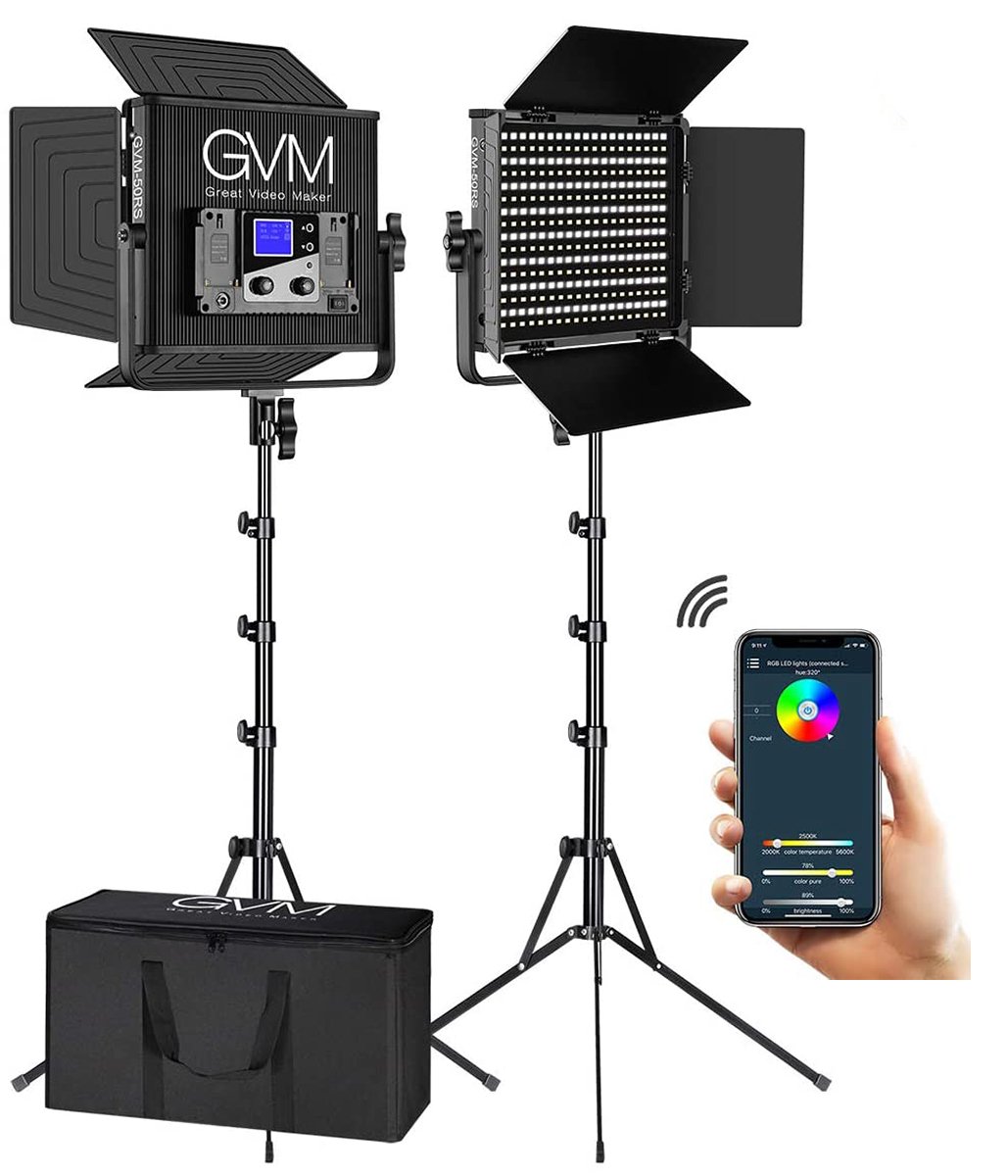
LED panel lights by GVM - This shows a set with two panels, each with a few hundred LED bulbs, light stands and carrying case, and a remote control device to adjust strength and color of light output. This set uses red, green and blue LEDs, not the bi-color (tungsten and daylight) system shown in the video. Most LED lights can be powered by batteries or a wall-plug.
Not only are LED lights ubiquitous, they come in an amazing variety of types, sizes, shapes, and prices. Those I demonstrated in the video are just scratching the surface. Wireless remote control, either a dedicated controller or a smart phone app, is common.
The second LED light shown in the video is a RotoLight NEO II. This has several unique capabilities including continuous light or rapid synchro flash without recycle delay, wide color adjustability, remote control capabilities, and special effects including lightning and police/emergency vehicle flasher simulations. It has several accessories available, including a grip for hand-held work, filters, and a soft box. It can be mounted on the camera or any 1/4” - 20 thread and can operate on AA batteries or AC adaptor.
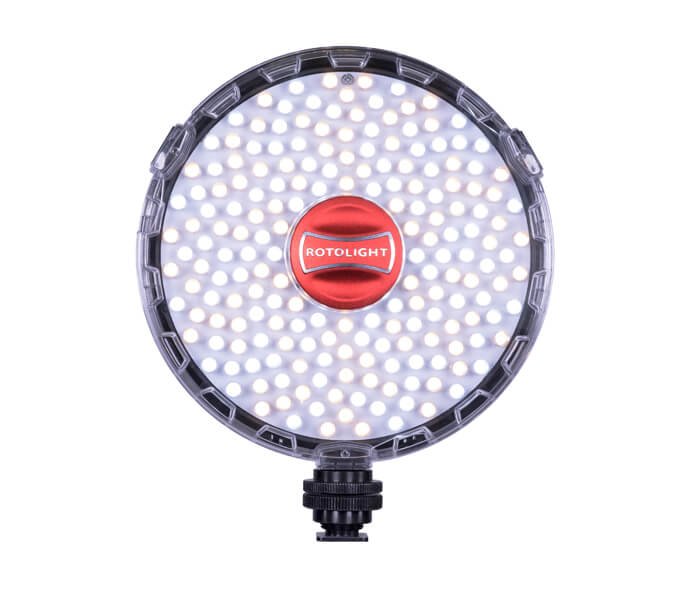
RotoLight NEOII
Smaller LED panels, perhaps 5x7 inches or so, often come with a “cold-shoe” mount to clip onto your camera. The models that flash use a synch cord or may have electrical contacts in a “hot-shoe” arrangement. Or, they can be hand-held off-camera or put on light stands. It looks to me that, although small, most are physically too large for safely mounting on the camera. A small, camera-mountable LED panel might stick up 6 inches or more above your camera’s accessory shoe. If bumped against something, that could put a lot of torque and stress on the camera shoe causing something to break. That is not really a new hazard, because hot-shoe mounted flashguns we have had for years always posed that same risk. Also, in my opinion, on-camera mounted lights of any kind always give ugly results.

Small LED panel light that can be mounted on your camera’s accessory shoe.
I might note that when I started my business, in the late 1970s, I bought continuous lights made by the Lowell company and used tungsten balanced films. As I started accumulating some money, I transitioned as rapidly as I could to electronic flash and daylight film, then transitioned into digital photography in the mid-1990s. Now, I am getting into making videos, and find I need continuous lights again, but heaven forbid going back to those terribly hot bulbs. The Lowell Omni Light (shown), originally used a 500- or 600-watt lamp that was extremely hot. The current model of the Omni has an available optional battery pack and much cooler low-voltage lamp.
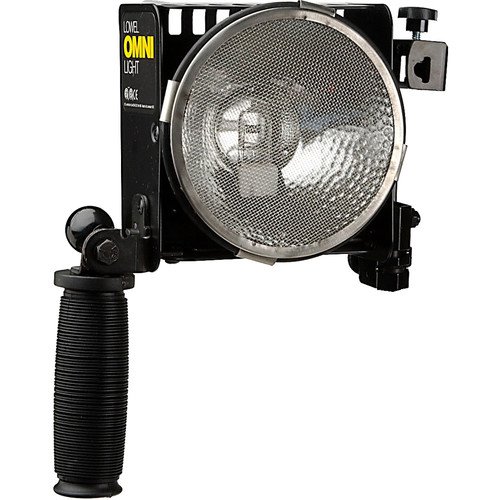
LowelI Omni Light
Below is an advertising photo for the Brightsabre by Polaroid. In the video, I briefly showed the Ice Light II by Westcott, and there are several other similar lights on the market. Not flat panels at all, these are tubular LED lights, reminiscent of wands from light-painting kits of the recent past and can even be used in that way. In a darkened room, set your camera for a time exposure, and “brush” with the wand to paint the non-moving subject with light. These tubular lights seem to be mostly intended for hand-held use, using either rechargeable battery or powered with an AC adapter cord. They can also be mounted on a light stand. They may not be tunable for color but do put out a wide pattern of constant daylight-balanced light over an adjustable range of brightness. They come with an orange plastic filter that snaps on for conversion to tungsten balance. Other filters may be clipped on instead should you need to shoot with custom colors of light.
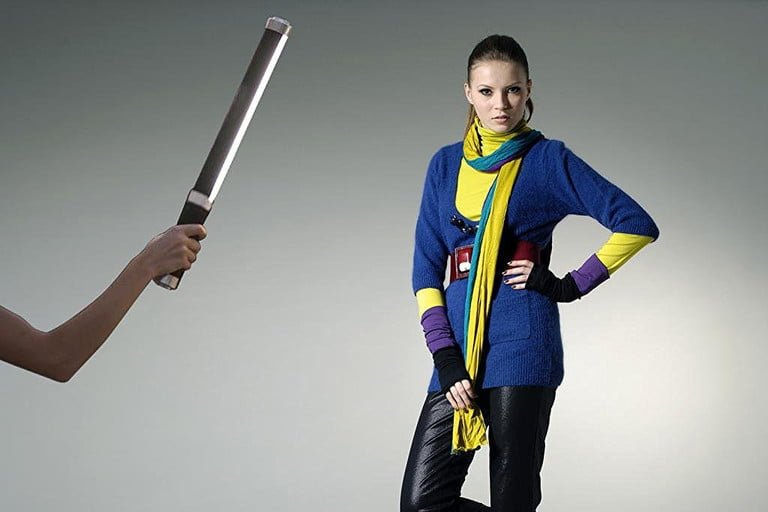
The Brightsabre by Polaroid
Another LED option, like the Aputure 300d below, looks like the traditional “bullet” shaped studio electronic flash head. These can be used with directional parabolic reflectors, as shown, or with light modifiers, like umbrellas or soft boxes, perhaps requiring an adapter. So, controlled soft-light effects are possible. Do some of these also flash? I do not know, but probably. But, being LED lights, they are not, at least at present, as strong as some of the older studio type electronic flash units that date back to the film era. Cool operation, low power consumption, good soft light capabilities and remote control for color and power may make this style of LED lights attractive for studio and location photographers and videographers.
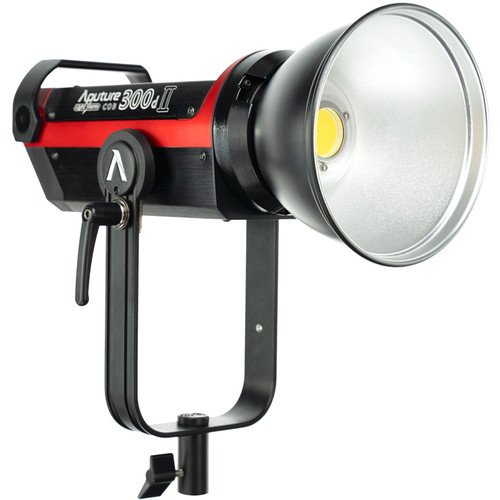
Aputure 300D
Do good things come in small packages? Check out the Lume Cube 2.0. This tiny LED light, measures about 2x2x2 inches, and is daylight balanced, for either continuous or flash light, has a built-in slave tripper so it can work in sync with other flashes, has a low light mode for long exposures, is waterproof to 30 feet, comes with a tungsten filter and soft light diffuser, and lists for under $100. Is there any competition? Yes, of course! There are several brands of comparable miniature highly capable LED lights. The Lume
Cube 2.0 has an adjustable camera shoe mounting or can use any 1/4” - 20 thread.

Lume Cube 2.0
Seen enough? But, wait - you can even buy continuous strips of daylight, tungsten or RGB LEDs pre-wired and on peel and stick backing, plus dimmer controls, etc. to build your own panel lights. Tutorials are on the net. And, there are flexible fabric mounted sheets of LED lights of various sizes, that can be draped over just about any support you can imagine. How about an “Amen” or a “Wow!”?
Please stay tuned for Part 2 of LED Photographic Lights - Not Just for Video.
Editor's Note: APS members Don Stephens, Jim Harrison and Darryl Neill now have (one each of) the Ikan LED light that's the background image for this article. Click on the thumbnail image above for a better view. These lights work great!

